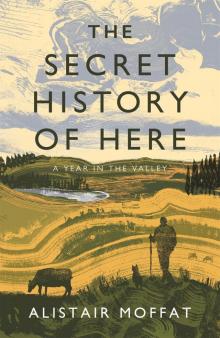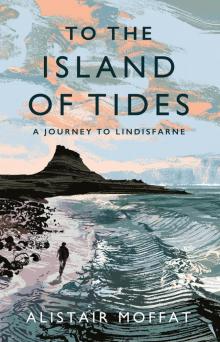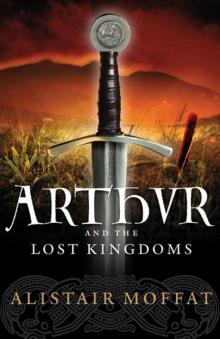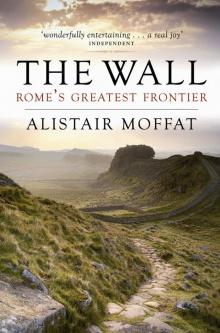- Home
- Alistair Moffat
Britain’s Last Frontier Page 21
Britain’s Last Frontier Read online
Page 21
After a long, freezing, exhausting journey, Hamilton and Stuart returned to Glasgow. Having buried the Stone in Kent, they had no incriminating luggage as they crossed the border. And, despite several fellow students and at least three others knowing the identity of the raiders and the police having encountered them more than once in London, Hamilton, Stuart, Vernon and Matheson were never questioned. To their immense relief and delight, the three men discovered that Kay Matheson had made it back to Glasgow and gone on home to Inverasdale. It seemed that, even though the whole enterprise had teetered on the brink of disaster time and again, it had succeeded entirely.
However, there was a problem – but not with the authorities. Alan Stuart’s father reckoned that the ancient stone would suffer badly from being buried in frosty ground in Kent. After six centuries indoors, under the Confessor’s Chair, it would be highly susceptible to damage if groundwater turned to ice and might, literally, fall to pieces. A pile of fragments might turn a triumph into a public relations disaster. Now that the police roadblocks had been stood down, another journey south to bring back the Stone might not be too dangerous. And so, a week after he had dug a hole in the cold ground of Kent, Hamilton, Bill Craig (who had managed to fit the trip into his busy diary) and a fellow student, John Josselyn, travelled south to retrieve what they hoped would be one piece of sandstone.
When they reached the spot, they were horrified to find that a group of Romanies had camped right on top of the hiding place. After a nod, a wink and some oblique discussion, the Romanies looked the other way while the students dug it up. It was undamaged and in one piece. They managed to fit it into the car by removing the front passenger seat and they each took turns to make a royal progress northwards on the Coronation Stone. After a slow but largely uneventful journey, they stopped on the A7, a few miles north-east of the village of Longtown, just inside the Scottish border. Having removed the overcoat concealing it, they produced a ‘gill of whisky and poured a libation over the Stone’s roughness’.
It was at that moment that the plan began to falter. In his superb account of the events of Christmas 1950, Ian Hamilton admitted that, as they approached Glasgow, they ‘had no further ideas of what to do, or where to go’. Eventually the Stone was hidden near Stirling and the police at last questioned some suspects, who included Hamilton, Stuart, Vernon and Matheson. They admitted nothing. Finally, on 11 April 1951, the Stone was left by Hamilton and others in the ruins of Arbroath Abbey at the high altar. It was the place where the famous Declaration was written and seemed appropriate. And, to the disgust of many Scots, the Stone of Destiny was again taken south, back to Westminster Abbey. No prosecutions were ever brought and no martyrs were made. It is a striking, memorable story – one that made a tremendous impact at the time and it still resonates. In his book, Ian Hamilton claims that it was a first step on the long road to a Scottish Parliament and maybe to independence. Perhaps it was. Certainly, it is a question that only history can answer. But a more obvious and immediate one might be – why all the fuss over a block of sandstone? What was it about the Stone of Destiny that awoke such strong feelings – on both sides of the border? Perhaps answers are to be found at Scone, its original home, a place very close to the Highland Line and where, for centuries, it occupied a central role in Scottish politics.
Names matter in history and especially in early history when documentary evidence is often thin or nonexistent. The Gaelic An Sgonn was the original name for Scone and it refers to the low mound now known as ‘Moot Hill’. More precisely, it means ‘a shapeless mound’ – a lump rather than a hill or mountain sculpted by geology and the weather. It has the sense of something manmade and is also the derivation of scone, a baked lump of dough, shapeless in untutored hands, that goes well with jam and butter.
On the flat summit of Moot Hill, close to Scone Palace, the home of the Earls of Mansfield and lying near the banks of the River Tay, sits a replica of the Stone of Destiny. This shapeless lump was Coronation Hill, where Scottish kings sat in their pomp on the ancient Stone and were solemnly crowned before an assembly of leading noblemen, churchmen and as many witnesses as could be gathered.
The Mound, An Sgonn, had another, more frequent function as the location for important public political events. In an age before mass media, politics had to be seen to be done. Here is an entry from the Chronicle of the Kings of Alba for the year 905: ‘And in the sixth year King Constantine and Bishop Cellach vowed on the Hill of Faith near the royal centre of Scone, after the fashion of the Gaels, to keep the laws and disciplines of the faith and also the rights of the churches and the gospels; from this day the hill has received its name, that is, the Hill of Faith.’
Public declarations from political figures on shapeless mounds still take place in Britain – or at least in a part of Britain that has clung on to many ancient traditions. At midsummer reckoned on the old calendar – that is, 5 July and not late June – Tynwald Day takes place at St John’s in the centre of the Isle of Man. On Tynwald Hill, the king sat on the top while on lower levels there were magistrates, noblemen and officers of various sorts. The ceremonies first came on record in 979 but are almost certainly older. Modern Tynwald includes an important judicial function, something that echoes across a millennium and more and something that almost certainly took place on Moot Hill at Scone.
Each year the Deemsters stand forward and read out loud the new laws to be enacted. These two bewigged and robed lawyers read the law of Man in Manx Gaelic and it does not come into force until they do so. Known as ‘Breast Law’, what was once known by heart and not written down, it is a relic of ancient practice. Justice had to be seen to be done and courts sat on Tynwald Hill and the Deemsters handed down sentences which were often carried out there and then. The old meaning of deem or doom was ‘a judgement’.
Before the notables gather on the hill at St John’s, there is a procession and it gives some sense of the ceremony that may have taken place at Scone. What this signified was something straightforward. In the 10th century, Scone was the centre of royal power, the place where the elites of the kingdom gathered, not only where coronations took place until as late as the 17th century (with the unusual case of Charles II being crowned King of Scotland in 1651) but also where politics was played out. Here is an extract from John of Fordun’s Scotichronicon that explains what went on. Malcolm II reigned from 1005 to 1034: ‘The histories record that the aforesaid Malcolm was also so lavish or prodigal in gifts that, although he had held all the lands, regions and provinces of the whole kingdom in his own possession in the ancient manner, he kept hold of none of it for himself apart from the Moot Hill on which stood the royal seat at Scone where kings sitting on the throne in royal attire are accustomed to proclaim judgements, laws and statutes to their subjects.’
And yet virtually nothing remains. There are no ruins of a royal palace, no vestiges of a once-great church, no sense of a bustling centre of population, trade or diplomacy. All that can be seen is the shapeless lump of Moot Hill and, nearby, the grand house of an aristocrat. Scone is Scotland’s lost capital.
In 2007, Oliver O’Grady led a team of archaeologists to try to find it and he was spectacularly successful. Digging around the base of Moot Hill, the team found a massive ditch, the sort of barrier used to mark off the boundaries of sacred precincts in prehistoric Scotland. And in the bottom of the ditch tiny fragments of burnt wood were discovered. This was precious organic material that could be carbon dated and it turned out that archaeology confirmed history, the sole scrap of documentary evidence for early Scone, the entry from the Chronicle of the kings of Alba about the Hill of Faith. The pieces of burnt wood were firm evidence that the Mound, An Sgonn, was piled up as early as the closing decades of the 9th century. O’Grady commented, ‘[I]t seems entirely plausible to me to suggest that King Constantine II, or at least some of his successors, was responsible for the creation of this mound.’
Scone had become the centre of a kingdom known as Alba, still the
Gaelic word for Scotland. In the middle of the 9th century, Kenneth MacAlpin had consolidated his rule over both the Pictish kingdom and that of the Scots or Gaels in the west, what used to be known as Dalriada. History is rarely as clear-cut as the schoolboy soubriquet for Kenneth, the first king of the Picts and Scots. There had been predecessors who had ruled in both kingdoms. But, after his reign, there is a sense of a dynasty taking over the high kingship of Scotland south of the Mounth and sustaining itself. All Scottish kings are numbered from Kenneth MacAlpin and his great-nephew, Constantine II, reigned for a long time, from 900 to 943. And then he retired, becoming a monk, perhaps abbot of the monastery at St Andrews.
There must have been a 9th- or 10th-century church at Scone but no trace of it has ever been found. This is perhaps not surprising. At that time, the church in Scotland was almost wholly monastic and with an ascetic and hermitical character. Grand buildings and soaring spires did not much interest these pious communities. They sought not so much to glorify God in material ways but to find him in prayer, contemplation and the privations of a frequently harsh life. The early church was much impressed and influenced by the example of the Desert Fathers, Near-Eastern Christians who fled the cities and towns and sought peace and refuge in the deserts of Syria, Jordan and Sinai. In homage to their exemplary lives, the Gaelic word diseart is simply a rendering of desert and it meant ‘a hermitical community of monks’. At Scone, there is tradition that Constantine II caused the wooden cells and church of the ascetic monks to be rebuilt in stone.
In the Middle Ages, grandeur did eventually arrive on the bank of the Tay. Between 1114 and 1122, Augustinian Canons came from Nostell Priory in Yorkshire to found a new abbey, a building in keeping with Scone’s status as a royal centre. The relics of St Fergus were installed and the new church became a focus for pilgrimage. But much more important was the role noted by the English chronicler, Walter of Guisborough: ‘In the monastery of Scone, in the church of God, near to the high altar, is kept a large stone, hollowed out as a round chair, on which kings were placed for their ordination, according to custom.’
In 1559 the abbey’s ancient importance was suddenly erased from Scotland’s history. In the early, frantic and destructive years of the Reformation, a mob from Dundee arrived at Scone and destroyed the church, smashing its idolatrous sculpture and stained glass and severely damaging the fabric of the buildings. When the new owners of the abbey’s estates, the Ruthven family, rebuilt the abbot’s palace as a grand house, the rubble of Scone was near at hand and, over time, all traces of the ancient home of the Stone of Destiny were effaced. Oliver O’Grady said, ‘The importance of Scone – where kings were made and parliaments met – is only matched by how little we know about the reality of the place.’
By July 2007, some of the mists of history had begun to disperse. O’Grady’s team made another sensational discovery. With the use of very sophisticated magnetic imaging techniques, they found the precise footprint of the abbey and its associated buildings. At more than 100 metres in length, the abbey was far larger than had been previously believed. The home of the Stone had, at last, been found. And what is more, the location of what amounted to Scotland’s first parliaments had also been discovered. Secular business was often done in medieval churches since they were generally the largest buildings available. Following the example of Tynwald on the Isle of Man, Scone Abbey is likely to have been the place where decisions were hammered out and, on formal occasions, the starting point for processions to the mound, Constantine II’s Hill of Faith.
When O’Grady’s carbon-dated fragments of wood were found to point to an early date for the creation of Moot Hill, he grasped its pivotal importance immediately. ‘And that should be seen as a very significant moment in Scotland’s history because they are no longer identifying themselves as Picts and they are gathering, as it says in the text “in the manner of the Gaels” and they are holding their most important royal ceremonies on that mound.’
Far to the west, another hill – this time, a dramatic rock rising out of a flat, boggy plain – saw similar ceremonies of inauguration. In the Gaelic-speaking kingdom of Dalriada, kings were made on the summit of the spectacular fort at Dunadd. There, a footprint was chiselled out of the rock and a basin made, and inscriptions in Gaelic as well as what looks like a rock-cut throne. By placing his foot in the footprint, a king asserted symbolic domination over the land and, by sitting on the throne, he entered into a form of marriage with his kingdom and its people. Those who stood on the summit of Dunadd could see the tip of Ben Cruachan, the sacred mountain of Dalriada, far to the north.
Something similar went on at coronations at Scone, in the centre of the new kingdom of Alba. When kings were made on the Moot Hill, the Stone of Destiny was brought out of the abbey and used as a throne. Here is a passage from the Scotichronicon that describes the coronation of Alexander III in 1249. The climax was the appearance of a seannachie and the recital of the king’s genealogy, a ritual that reminded the audience of the customs of the Gaels and a moment that echoed down the centuries to the Highlanders who stood on the moor at Culloden:
With due reverence they installed him there on the royal seat which had been bedecked with silk cloths embroidered with gold. So when the king was solemnly seated on this royal seat of stone, with his crown on his head and his sceptre in his hand, and clothed in royal purple, and at his feet the earls and other nobles were setting down their stools to listen to a sermon, there suddenly appeared a venerable, grey haired figure, an elderly Scot [meaning a Gael]. Though a wild Highlander he was honourably attired after his own fashion, clad in a scarlet robe. Bending his knee in a scrupulously correct manner and inclining his head, he greeted the king in his mother tongue, saying courteously: ‘God bless the king of Albany, Alexander macAlexander, macWilliam, macHenry, macDavid . . .’
The royal seat of stone at Scone stood in the centre of Scotland’s history and, when Oliver O’Grady dated the creation of the Moot Hill to the reign of Constantine II, King of Alba (or Albany), he may be forgiven for saying, in the excitement of the moment, ‘The lab results are in a sense nothing less than a birth certificate for Scotland.’ And he was right – the birth of the kingdom of Scotland can be fairly said to have taken place at Scone.
Even though these extraordinary discoveries were made 57 years after Ian Hamilton and his friends mounted their sensational raid on Westminster Abbey, there was nevertheless a widespread, intuitive sense of the central, symbolic importance of the Stone of Destiny. It was present at the birth of Scotland. It was stolen and it needed to be taken back because, as nationalists, Hamilton’s raiders wished to see Scotland reborn.
In 1996, their original aims were at least in part fulfilled. A failing, unpopular Conservative government needed to shore up as much support as possible in Scotland and so Secretary of State for Scotland Michael Forsyth, the MP for the marginal seat of Stirling, engineered the return of the Stone of Destiny. In a strange, snapshot moment, television pictures showed the Stone being trundled across the border at Coldstream Bridge in the back of an army Land Rover. With pipers on either side of the bridge and the Secretary of State and his entourage on foot, moving very slowly on a damp November morning, the procession looked more like a funeral than a triumphant homecoming. On 30 November, St Andrew’s Day, with a little more pomp and cheer, the Stone was conveyed up the Royal Mile from Holyrood Palace to Edinburgh castle to join the Scottish regalia. The Conservatives lost the election a year later and the new Labour government put in train the legislation to bring into being a Scottish Parliament. It reconvened in 1999.
Republished in 2008, Ian Hamilton’s excellent account of his great adventure, The Stone of Destiny, included a poignant postscript from the author, by this time 84 years old:
I began the last chapter of my book by saying I had never seen the Stone again. It had been my intention to wait until Scotland achieved independence before paying it a visit. We are so nearly there that it makes no odds. An occasion
is coming up in 2008 when I may break my long abstinence . . . Alex Salmond and the Scottish Government are to give a reception in the Great Hall of Edinburgh Castle . . . If invited, and I am told I will be, I shall go. If my country’s First Minister takes my arm and leads me through to the Crown Room to see the Stone I shall go with him. I have never sought an honour, but I can think of none greater.
As for my long life, breaking into a holy place is not good preparation for entry into the most conservative of professions, but I survived. We three survivors of the original four are now very old. This exercise in looking back is not typical of me, nor so far as I know of them. Life is for living and even at my great age I prefer a motorbike to a keyboard.
I repeat myself as old men do. Remember us with some kindness. What we did for Scotland and what we do for Scotland we do for all the world.
When on 25 March 1707 James Ogilvie, Earl of Seafield, Chancellor of Scotland, signed the Act of Union, ending Scotland’s ancient independence, and merging the two parliaments of Scotland and England into the United Kingdom Parliament, he threw down the quill with these words: ‘Now there’s the end of an auld sang’.
It may be, it just may be, that on Christmas Day 1950 four young people wrote a new verse to that old song. Whatever we did, the song is still being sung.
12
The Wild West
CARPENTERS WERE busy in Perth in the weeks leading up to the appointed day, hammering, sawing, planing and nailing, and the town simmered with anticipation. At the vast cost to the royal exchequer of £14 2s. 10d., barriers were erected on three sides of the North Inch. An open area to the west of the town, the North Inch has the River Tay as the boundary of its fourth side. A grandstand was built around the summerhouse of the great church of the Blackfriars, founded in the 13th century and dedicated to the Blessed Virgin and St Dominic. The Lord Prior had been busy with arrangements, his cellarer ordering the royal apartments to be made ready and provisions for many visitors to be found and brought to the kitchens. It was late autumn 1396 and King Robert III of Scotland and his court were riding to Perth to see justice done in a spectacular fashion. Accompanying his entourage were other notables, the Duke of Albany, who was the king’s brother, and many French, English and Scottish lords. All would witness a remarkable event – the resolution of a dispute in a trial by combat on the North Inch.

 The Secret History of Here
The Secret History of Here The Night Before Morning
The Night Before Morning To the Island of Tides
To the Island of Tides Arthur and the Lost Kingdoms
Arthur and the Lost Kingdoms Britain’s Last Frontier
Britain’s Last Frontier The Faded Map: The Lost Kingdoms of Scotland
The Faded Map: The Lost Kingdoms of Scotland The Wall
The Wall